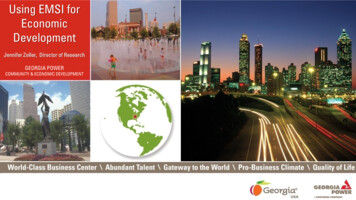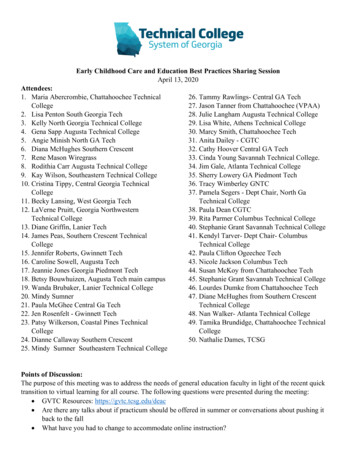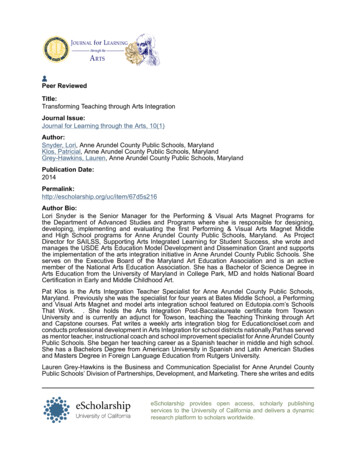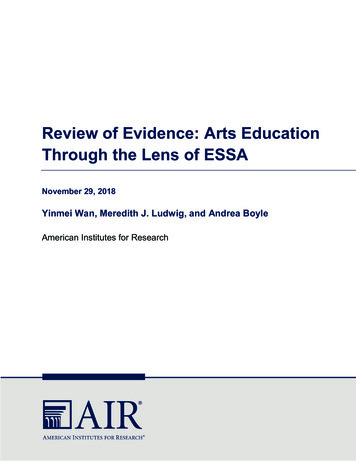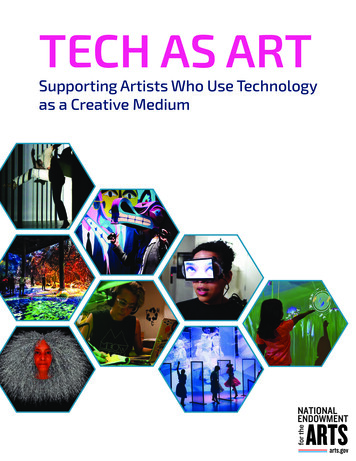
Transcription
TECH AS ARTSupporting Artists Who Use Technologyas a Creative Medium
FRONT COVER:142653871. Daniel Suominen in 16 [R]evolutions by Troika Ranch. Photo by Richard Termine,full photo page 202. Refik Anadol, Machine Hallucination. Photo courtesy of Refik Anadol Studio,full photo page 883. Stephanie Dinkins, Not the Only One. Image courtesy of Stephanie Dinkins,full photo page 924. Paisley Smith and Lawrence Paul Yuxweluptun, Unceded Territories.Photo courtesy of the artists, full photo page 205. Darcy Neal. Photo courtesy of Darcy Neal, full photo page 936. Sondra Perry, Young Women Sitting and Standing And Talking and Stuff (No, No,No). Photo by Sondra Perry, courtesy of the artist and Bridget Donahue, NYC,full photo page 207. Kyle McDonald, ELEVENPLAY, and Rhizomatiks Research, discrete figures.Photo by Suguru Saito, full photo page 248. Design I/O, Connected Worlds. Photo courtesy of David Handschuh,full photo page 89
TECH AS ARTSupporting Artists Who UseTechnology as a Creative MediumBased on a field scan by the National Endowment for the Artsin collaboration with the Knight Foundation and the Ford Foundation
June 2021National Endowment for the Arts400 7th Street, SWWashington, DC 20506arts.govProduced by the National Endowment for the Arts’ Office of Research & Analysis in collaborationwith the Media Arts DivisionSunil Iyengar, Director, Research & AnalysisPatricia Moore Shaffer, Deputy Director, Research & AnalysisPatricia Germann, Research Administrative OfficerJax Deluca, Media Arts DirectorSarah Burford, Media Arts SpecialistAvril Claytor, Media Arts SpecialistDon Ball, EditorKelli Rogowski, DesignerResearch Team MembersSarah Lutman, Principal, 8 Bridges WorkshopJessica Fiala, Research Associate, 8 Bridges WorkshopPatricia Johnson, Associate, 8 Bridges WorkshopGreta Rudolph, Associate, 8 Bridges WorkshopJessica Clark, Principal, Dot Connector StudioKatie Donnelly, Co-Founder, Dot Connector StudioMichelle Polyak, Assistant Director, Dot Connector StudioSupported byFord FoundationJohn S. and James L. Knight Foundation202-682-5496 Voice/TTY(a device for individuals who are deaf or hearing-impaired)Individuals who do not use conventional print materials may contact the Arts Endowment’sAccessibility Office at 202-682-5532 to obtain this publication in an alternate format.This publication is available free of charge as a downloadable PDF at arts.gov.
ABOUT THE REPORTThis report, Tech as Art: Supporting Artists Who Use Technology as a Creative Medium, presentsfindings from a field scan commissioned in 2019 by the National Endowment for the Arts inpartnership with the Ford Foundation and the Knight Foundation. The purpose of the scan was tomore fully understand how artists are incorporating digital technologies in their creative work andto learn more about the current and prospective sources of support for these artistic practices.Funders reading the report then can make smarter decisions on how to enhance support for thisfield. The research is grounded in literature reviews, interviews, and group discussions with artistsand practitioners across the United States.The report shares detailed findings; identifies challenges; and ends with recommendations fordifferent stakeholder groups, including funders, arts practitioners, policymakers, and educators.There are five main findings:yyyCode, computation, data, and tool-building are fundamental to technology-centered (“techcentered”) artistic practice. Code, computation, and data can facilitate artists’ creative collaborations by enablingartists to create works across artistic forms and contexts. Tool-building is both an artistic pursuit and a vital practice for this field. It expands accessto software and computational thinking, and it supports the creativity of other artiststhrough an open-source ethos.Because the field is so diverse and dynamic, it has eluded easy labels. As a result, more traditionalarts organizations and funders often have trouble finding entry points to engage with it. Tech-centered artists work fluidly across disciplines and formats, creating genre-defyingartworks and spanning discipline-based curatorial and academic specialties. Artists create projects within and between virtual and physical spaces, requiring distinctapproaches to presentation, public engagement, accessibility, and archiving. Arts organizations and funders face numerous challenges engaging with tech-centeredartistic practices. These challenges include limited staff expertise, limited infrastructure,and difficulties in understanding how to evaluate artistic projects in this field.Tech-centered artists have managed successfully to establish peer organizations, regionalhubs, exhibition spaces, festivals, information networks, and academic departments acrossthe United States. Physical hubs, in-person gathering spaces, and festivals provide opportunities for corecommunity-building, learning, debate about contemporary trends, public engagement,training, exhibition, and specialized programs such as residencies and incubators. Online resources and communities provide training and networking opportunities that oftenare free to the public. They enable participation beyond physical hubs and are particularlyimportant for artists outside urban centers.Tech as Art: Supporting Artists Who Use Technology as a Creative Mediumi
yyii Colleges and universities are prominent employers, incubators, and resource providers fortech-centered artists. While there are interconnected networks supporting tech-centered artistic practices, thereare also significant resource gaps in the U.S.-based arts infrastructure, such as access totechnical facilities, training, and exhibition opportunities, which can inhibit the growth ofopportunities for artistic and professional development.Career pathways for tech-centered artists are highly varied, though as a group these workersencounter many of the same obstacles as artists in general. Despite formal educational attainment, tech-centered artists described themselves aslargely self-taught and reliant on artist-founded organizations, community hubs, and onlineresources for artistic and professional growth. Artists cultivate multiple income streams to make a living—balancing freelance andcreative gigs, employers, grants and awards, donations, and other income sources.Thoughcorporate and commercial work are prominent income streams, these artists as workersshare the same income instability and time constraints as artists in other disciplines. Many of the artists observed in the field scan are entrepreneurial, collaborating acrossindustry sectors, contributing to their local arts and cultural communities, and establishingbusinesses that draw on creative and digital skills.Tech-centered artists are admirably poised to grapple with larger societal and sectoralchallenges—whether engaging with audiences during the COVID-19 pandemic or respondingto calls for greater equity and inclusion in the arts and technology. They can be invaluablepartners for policymakers, educators, and practitioners in arts and non-arts sectors alike. These artists bring specialized expertise in using digital technology to connect withaudiences across physical and virtual spaces. Diversity, equity, and inclusion are common themes in this growing field of practice,and they can contribute to accelerated action in addressing racial inequities and socialinjustices across the arts and technology and other sectors. Many of the artists discussed in this report seek to engage local communities, addresssocial issues, and bridge digital divides through their tech-centered arts projects. Boundlessopportunities exist for the arts and cultural sector to build beneficial partnerships with techcentered artists and collaboratively imagine directions for future creative programming.National Endowment for the Arts arts.gov
CONTENTSPreface. 7Introduction. 9Purpose of the Research. 9Research Methodology and Scope. 9The Report’s Focus. 11How the Report is Organized. 13CHAPTER 1: Exploring the Work. 15Artistic Influences and Foundations. 16Artists have a rich history centering technology as core to their practice. 16Recent Historical Overview: 1960s to the Present. 16Technology in a New Era. 21Code, computation, and data are essential building blocks for artistic creation. 21Creative and Functional Approaches. 21Code and Data as Artistic Material. 22Data as Critical Lens. 24Code, Computation, and Data as Connective Tissue. 24Tool-building is an artistic pursuit and a vital foundation for creators. 25Overview of the Tool-Building Process. 26Reasons for Tool-Building. 27A Collective Ethos. 27Hacking Devices. 29Unseen Labor. 29Crossing Contexts and Disciplines. 32Artists work fluidly among disciplines, genres, and formats. 32Crossing Disciplines and Categories. 32Explaining Cross-Disciplinary Practices. 34Artists create projects within and between virtual and physical spaces. 36Art in the Palm of Your Hand. 37Location. .37Augmentation. .37Mobile Applications. .38Viral Campaigns. .38Virtual Realities. 38Digital Art in Public Spaces. 40Artists extend established arts disciplines through creative experiments with technology. 42Established Disciplines and Continual Evolution. 43Methods of Extending Forms. 43Process & Development. .43Tech as Art: Supporting Artists Who Use Technology as a Creative Mediumiii
Aesthetics & Audience Experience . .43Format & Content . .44Preserving “New” Forms . .44CHAPTER 2: Navigating the Ecosystem .47Interconnected Communities, Hubs, and Gathering Spaces . 48In-person gatherings, workshops, festivals, and conferences are core hubs for learningand community building . 48Gathering Spaces . 48Professional Development & Technical Training . 50Festivals and Conferences . 50Online resources and communities expand access and enable participation . 51Critical Discourse and Discovery . 52Colleges and universities are prominent employers, incubators, and resource providers . 53Increasing Degree Programs . 54Digital Technologies Are Changing Traditional Arts Training . 54Colleges and Universities as Resource Centers . 54Challenges and Opportunities to Working Within Academia . 54High Levels of Advanced Degree Attainment . 55Entry Points and Strategies for Making a Living . 56Routes into tech-centered artistic practices follow many paths, including informalexperimentation, formal degrees, arts training, and technology careers. 56Youth Technology Training. 56Professional Pathways. 57Artists cultivate multiple income streams to make a living . 58Portfolio Careers . 59Overlaps with Other Arts Practices . 60Artists collaborate across sectors and establish businesses that build on creative anddigital skills . 60Collaboration, Translation, and Thought Leadership Across Sectors . 61Artists as Entrepreneurs . 62Corporate and commercial work are prominent income streams that present artists withboth opportunities and challenges . 63Opportunities for Artists and Industry. 63Obstacles Confronted by Artists . 64Fostering Industry Relationships on an Individual Level . 64CHAPTER 3: Next Steps for Supporters .67Understanding Challenges . 67Artist Challenges . 67Artists often rely on commercial software, which can be expensive, or on open-sourcetools, which can be built on the unpaid labor from the artists who produce andmaintain them . 68Artists often describe gaps in resources for project development . 68Financial difficulties create a number of obstacles for artists working in the field. 69Artists may pour time, energy, and funding into projects with limited distribution andpresentation options . 69ivNational Endowment for the Arts arts.gov
The decentralized nature of the expansive arts-and-technology field poses challengesrelated to a lack of shared language, information, and critical coverage of artists’ work . 70Organization Challenges . 70Philanthropic funding sources can find it challenging to provide avenues of supporttailored to the unique working requirements of arts-and-technology practice . 70Art institutions often lack staff expertise to curate, present, interpret, and engageaudiences with artists who use digital technology as a creative medium. 71Arts institutions frequently lack the technological infrastructure to adequately supportarts-and-technology projects . 72Barriers & Regional Challenges. 72Recommendations. 74Expand Expertise and Technical Capacity . 76Review Program Priorities and Outreach Plans . 77Lift Barriers to Collaboration Across Arts and Non-Arts Sectors . 77Strengthen Technological Infrastructure Serving Arts and Culture . 78Offer Project Development, Presentation, and Exhibition Opportunities . 80Deepen Public Understanding of the Field’s Value and Impact . 81Acknowledgments . 82APPENDIX A: Case Studies .85Case Study: 3-Legged Dog . 85Case Study: Refik Anadol . 87Case Study: Design I/O . 89Case Study: Stephanie Dinkins . 91Case Study: Darcy Neal . 93Case Study: Processing Foundation . 95Case Study: Scatter . 97Case Study: Lance Weiler . 99Case Study: Amelia Winger-Bearskin . 101APPENDIX B: Glossary of Terms .103APPENDIX C: Works Cited . 107APPENDIX D: Organizations Mentioned . 114Tech as Art: Supporting Artists Who Use Technology as a Creative Mediumv
This pageintentionallyleft blankviNational Endowment for the Arts arts.gov
PREFACEThis National Endowment for the Arts report is a field scan of arts and technology in practice,reflecting upon the ways artists engage with—and develop—technology to remix, augment, andinterrogate structures within arts and culture. While these tech-focused artists often pioneer newforms of expression, they also contribute to innovation in the wider sector, alongside potentialavenues for economic growth. For these reasons and more, a comprehensive look at these artistsand their support systems was of interest to the Arts Endowment and its partners, the FordFoundation and the Knight Foundation.This report offers insights for the broader arts and cultural sector, and also the fields of science,technology, engineering, and math (STEM), to discover shared goals and priorities with techfocused artists and related practices. For example, the artists profiled in this report haveestablished a range of culturally relevant arts projects and organizations that bridge digital dividesand build 21st-century skillsets—services of profound importance to communities with limitedaccess to training and education. In addition, they increasingly embrace the principles of diversity,equity, inclusion, and accessibility in their work, while routinely exploring ethical issues aroundtechnology—such as data privacy, artificial intelligence, and representation—valuable topics forthose seeking to build a more equitable and diverse future.The backdrop to this research is the COVID-19 pandemic, which forced the closure of publicgathering spaces around the world in 2020. Artists and cultural organizations had no choice butto pivot practices to reach audiences virtually. As the shutdowns demonstrated, audiences aremore than ready to engage digitally—yet many of the practitioners in this report view culturalorganizations as underprepared to support the growing digital and virtual needs of artists andaudiences. This context magnifies the role of the present report and suggests that more strategicinvestments are needed to boost the cultural sector’s capacity to serve artists and the public bothin physical and in virtual spaces. While the need for these investments was evident prior to theCOVID-19 pandemic, it has certainly become a preeminent concern today.Here at the Arts Endowment, we have deepened our commitment to support activities at theintersection of arts and technology through our flagship Grants for Arts Projects program inthe Media Arts discipline. We encourage applications for projects of all sizes from a variety oforganizations—large and small, rural and urban. In addition to providing outreach and technicalassistance to prospective applicants, we act as a catalyst for future partnerships and raise thevisibility of existing initiatives that offer exemplary models and practices for connecting localcommunities with tech-focused arts programming.As you embark on this report, I urge you to devote time to understanding how arts-and-technologypractitioners can benefit your constituents and professional networks now and in the near future.Together, we can build the foundation for a more resilient and thriving arts and cultural ecosystemthat includes greater support for arts practices focused on technology as a creative medium.Jax DelucaMedia Arts DirectorNational Endowment for the ArtsTech as Art: Supporting Artists Who Use Technology as a Creative Medium7
This pageintentionallyleft blank8National Endowment for the Arts arts.gov
INTRODUCTIONPurpose of the ResearchThis report responds in part to the National Endowment for the Arts’ FY 2017-2021 ResearchAgenda, which called for new investments in exploratory studies that describe factors thatenhance or inhibit arts participation and/or arts and cultural assets, including the arts-and-culturalworkforce.1Even before the COVID-19 pandemic pushed many facets of life online, Americans spent asignificant proportion of their lives there. The Pew Research Center’s 2019 data (pre-COVID)showed that 90 percent of American adults used the internet, and roughly three-quarters ofAmerican adults had broadband internet service at home.2 Nearly all American adults—96percent—reported owning a cellphone of some kind in 2019, and the share of Americans whoowned smartphones in 2020 reached 81 percent.3 The Pew 2019 data also showed that about 72percent of American adults used social media, including Facebook, Twitter, Pinterest, Instagram,and LinkedIn.4 Data from the Arts Endowment’s 2017 Survey of Public Participation in the Artsshowed 74 percent of U.S. adults used electronic/digital media to consume artistic or arts-relatedcontent, while 29 percent of adults who created art shared it on the internet.5 Among U.S. adultswho created and shared art, the internet was a major vehicle for doing so.6 A previous version ofthe survey revealed that 46 percent of all adults who created visual art did so using electronic/digital media, while 28 percent of adults who created or performed music relied on media for thispurpose.7Research Methodology and ScopeThe project’s research plan focused on learning directly from the lived experiences of workingartists engaging with technology through formal and informal arts settings, including those workingin nonprofit, commercial, and community-based contexts spanning multiple sectors and artisticdisciplines. Artists participating in the research were selected by National Endowment for the Artsstaff in consultation with funding partners at the Ford and Knight foundations, with members ofthe project’s Technical Working Group of national experts, and with the research team. Artists werechosen both to reflect the breadth of the U.S. in terms of race, gender, age, and geography, and toaccount for diverse areas of creative practice, levels and types of academic preparation, and stagesof career.1National Endowment for the Arts, “Research Agenda,” 4.2Pew Research Center, “Broadband Fact Sheet.”3ibid, “Mobile Fact Sheet.”4ibid, “Social Media Fact Sheet.”5National Endowment for the Arts, 2017 Survey of Public Participation in the Arts. This percentage does not includeother musical forms, including classical music or opera, jazz, or Latin, Spanish, or salsa music.6National Endowment for the Arts, U.S. Patterns of Arts Participation, 13.7National Endowment for the Arts, A Decade of Arts Engagement.Tech as Art: Supporting Artists Who Use Technology as a Creative Medium9
Data for this field scan was collected through the following activities:1. Four in-person roundtables with a total of 66 practicing artists, held in New York City, LosAngeles, Miami, and Detroit,8 all conducted in fall 2019;2. One virtual town hall event, open to the public, engaging 104 artists and arts leaders from 24states and two foreign countries, held in early 2020;3. Twenty field interviews with leading practitioners, including curators, arts writers, and leadersof academic departments, conducted in spring 2020;4. Nine artist case studies, each involving multiple interviews in 2020;5. A literature review of resources and publications relevant to the research questions;6. A grant portfolio analysis of 150 recent National Endowment for the Arts grant awards relatedto arts and technology; and7. Three meetings with a Technical Working Group of field representatives to review and discusspreliminary findings and draft of the report.Through these activities, the research team explored the following research questions:1. What are the ways artists use technology as a creative medium in their artistic practice?a.What is the range of examples of such work across artistic disciplines and technologyplatforms? Are there categories or classifications for identifying and describing this work, forexample, by genre or sub-discipline or by type of technology used?b. What is the range of career paths or trajectories taken by artists working with technology asa creative medium? Across artistic disciplines, how are these pat
Tech as Art: Supporting Artists Who Use Technology as a Creative Medium . i. ABOUT THE REPORT. This report, Tech as Art: Supporting Artists Who Use Technology as a Creative Medium, presents . findings from a field scan commissioned in 2019 by the National Endowment for the Arts in partne
